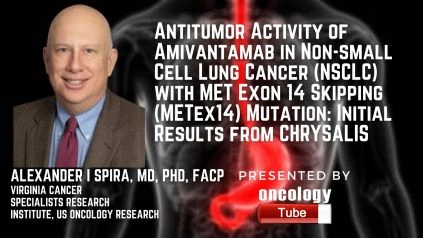Alexander I Spira, MD, Ph.D., FACP from the Virginia Cancer Specialists Research Institute, US Oncology Research speaks about Antitumor Activity of Amivantamab in Non-small Cell Lung Cancer (NSCLC) with MET Exon 14 Skipping (METex14) Mutation: Initial Results from CHRYSALIS.
Link to Study
https://clinicaltrials.gov/ct2/show/NCT02609776
The Context:
Breakthrough Therapy Designation has been granted to amivantamab (ami), an epidermal growth factor receptor (EGFR)-MET bispecific antibody, for the treatment of EGFR exon 20 insertion NSCLC that has progressed after platinum chemotherapy. The significance of ami in primary METex14 NSCLC is being investigated due to its bispecific character.
Methodologies:
The MET-2 cohort in the CHRYSALIS trial (NCT02609776) is administering the recommended phase 2 dosage (RP2D) of 1050 mg (1400 mg, 80 kg) ami to patients with METex14 NSCLC whose illness has progressed or who have rejected the current course of treatment. The researchers used RECIST v1.1 to evaluate the answers.
Achieved Results
As of April 19, 2021, 18 patients with METex14 NSCLC had received ami (15 were still receiving it): median age was 70 years, 67 percent were women, and median prior lines were 2 (range, 0–10), including crizotinib (n=5), capmatinib (n=2), tepotinib (n=2), and other anti-MET treatments (n=4). Nine (64 percent) of the 14 patients with at least one post-baseline illness evaluation showed partial responses (5 confirmed, 4 seeking confirmation; Table), and five had stable disease (-25 percent, -25 percent, -20 percent, -12 percent, and 0 percent); four were awaiting initial assessment. Four out of five verified responders are still on therapy, while one quit after 12 months. The average length of therapy for responders was 6.5 months (range: 4.3–12.2). The safety profile of amivantamab at the RP2D was similar with previous reports (Sabari 2021 JTO 16(3):S108, OA4).
Baseline ctDNA revealed probable resistance mechanisms in two of the ten patients who had previously taken a MET tyrosine kinase inhibitor (TKI): PIK3CA mutation in one and CDK4/EGFR amplification and a putative secondary MET mutation (A1251V) in the other. There was no change in MET TKI resistance in 8 of the points.
Final Thoughts:
This first report of ami activity in METex14 NSCLC validates its bispecific mode of action, which was previously described in EGFR exon 20 insertion NSCLC. Enrollment is still open, and new information will be given as it becomes available.

